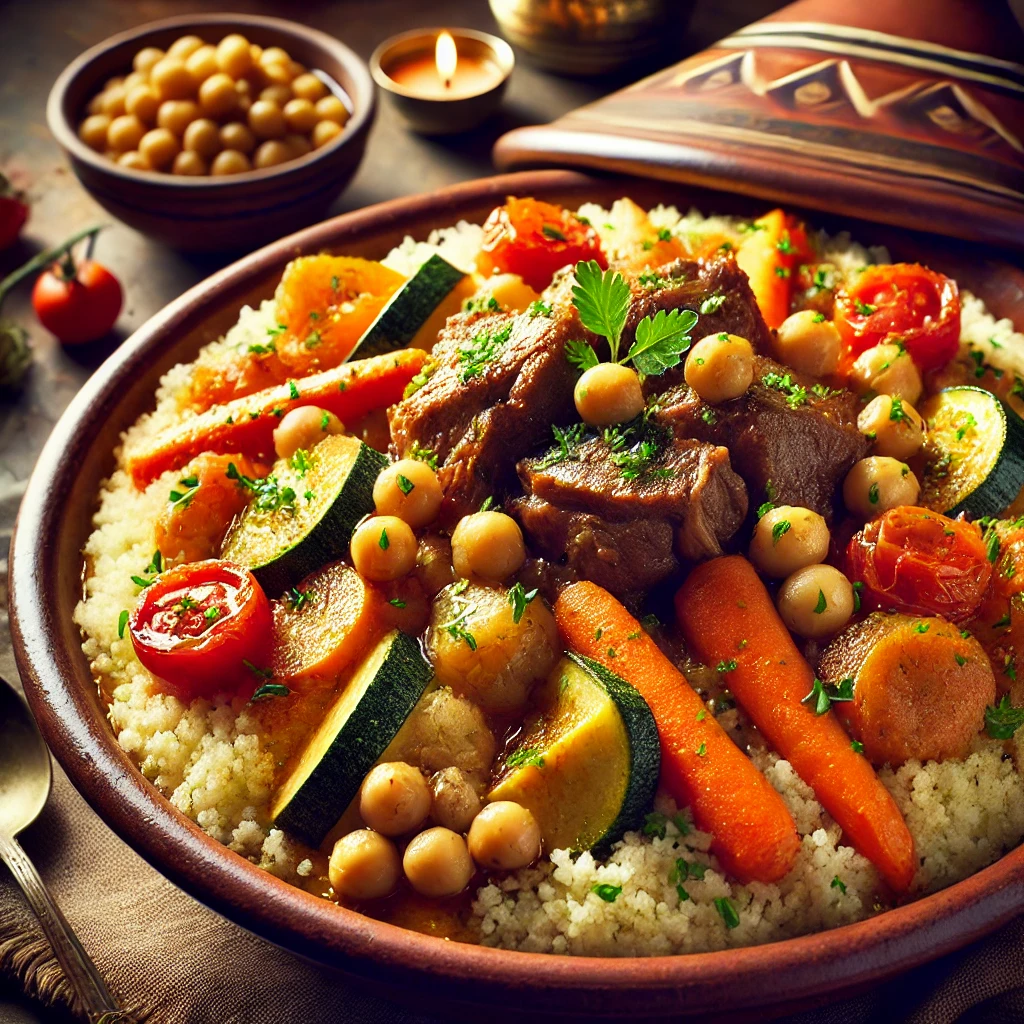
Introduction
Couscous is more than just a dish; it is a symbol of tradition, culture, and hospitality across North Africa. Originating from the Maghreb region, which includes Morocco, Algeria, Tunisia, and Libya, couscous has been a staple food for centuries. This simple yet versatile dish consists of tiny granules of steamed semolina wheat, often served with vegetables, meat, and flavorful broth. Its preparation and presentation reflect the rich culinary heritage of the region.
In this article, we will explore the history, ingredients, preparation methods, serving traditions, and cultural significance of couscous. Whether you are a food enthusiast or a traveler looking to experience North African cuisine, this comprehensive guide will give you a deep understanding of one of the most beloved dishes in the world.
1. The History of Couscous
Couscous has ancient origins, dating back to at least the 9th century. Historical evidence suggests that the Berbers, the indigenous people of North Africa, were among the first to prepare couscous. Archaeological discoveries, including cooking utensils resembling couscous steamers, have been found in North African sites from the Middle Ages.
Over time, the dish spread across the Mediterranean and even reached parts of the Middle East and Europe through trade and migration. Today, couscous is not only a key dish in Maghrebi cuisine but is also enjoyed in countries such as France, Italy, and even parts of sub-Saharan Africa.
2. Ingredients of Traditional Couscous
The beauty of couscous lies in its simplicity and adaptability. The basic ingredients for a classic couscous dish include:
- Couscous grains –
- Made from semolina wheat, which is rolled and steamed to create light and fluffy granules.
- Meat –
- Common choices include lamb, chicken, or beef, slow-cooked until tender.
- Vegetables –
- Carrots, zucchini, potatoes, chickpeas, tomatoes, and bell peppers add color and nutrition.
- Spices –
- Cumin, coriander, saffron, cinnamon, and turmeric create a fragrant and flavorful broth.
- Broth –
- A rich, savory sauce made from simmering meat, vegetables, and spices.
- Herbs and garnishes –
- Fresh cilantro, parsley, and sometimes almonds or raisins for added depth.
3. How Couscous is Prepared
Preparing couscous the traditional way is a labor of love. The process involves:
- Steaming the couscous –
- Unlike rice, couscous is not boiled but steamed in a special pot called a couscoussier.
- This ensures that the grains remain fluffy and separate.
- Cooking the meat and vegetables – The meat is browned, and the vegetables are sautéed with spices before being simmered to create a rich broth.
- Layering the dish –
- The couscous is placed on a large serving plate, with the meat and vegetables arranged on top, and the broth poured over everything.
While modern instant couscous is available and convenient, traditional hand-rolled couscous is considered superior in texture and flavor.
4. Presentation and Serving Style
In North African culture, couscous is more than just a meal; it is an experience. It is typically served on a large communal platter, symbolizing unity and sharing. Families and guests gather around the dish, using spoons or even their hands to enjoy the meal together.
Couscous is often accompanied by a side of harissa, a spicy chili paste, to add an extra kick. Some variations include dried fruits like raisins or apricots, which give a delightful contrast of sweet and savory flavors.
5. Variations of Couscous Across the Region
While the core concept of couscous remains the same, different countries have their own unique interpretations:
- Moroccan Couscous
- – Often served with seven vegetables and sometimes sweetened with caramelized onions and raisins.
- Algerian Couscous
- – Known for its bolder spices and sometimes served with spicy merguez sausage.
- Tunisian Couscous
- – Spicier, often featuring seafood like fish or shrimp.
- Libyan Couscous
- – Usually softer in texture and accompanied by a tomato-based sauce.
Each variation reflects the local ingredients and culinary traditions of the respective country.
6. The Cultural Significance of Couscous
Couscous is deeply rooted in North African culture and traditions. It is often prepared for special occasions such as weddings, religious celebrations, and family gatherings. In Morocco, for example, Fridays are considered couscous day, where families come together after prayer to share a communal meal.
The dish also carries symbolic meanings. The round grains of couscous are sometimes associated with abundance and prosperity, making it a popular dish during festive events.
7. Couscous in Modern Cuisine
As North African cuisine gains international recognition, couscous has found its way into modern kitchens worldwide. Chefs experiment with fusion dishes, incorporating couscous into salads, grain bowls, and even desserts.
In Europe, particularly in France, couscous is a beloved comfort food, thanks to the influence of North African immigrants. Supermarkets now offer pre-cooked couscous, making it easier than ever to prepare at home.
8. How to Make Couscous at Home
If you want to try making traditional couscous, here’s a simple recipe:
Ingredients:
- 2 cups couscous
- 2 tablespoons olive oil
- 1 teaspoon salt
- 1 teaspoon cumin
- 1 teaspoon paprika
- 1 carrot, sliced
- 1 zucchini, sliced
- 1 cup chickpeas
- 500g lamb or chicken
- 4 cups broth
Instructions:
- Heat oil in a pot, brown the meat, and add the vegetables and spices.
- Pour in the broth and let it simmer for 45 minutes.
- Steam the couscous over the broth using a steamer.
- Serve the couscous on a large plate, topped with meat, vegetables, and broth.
This recipe provides an authentic taste of North Africa in your own kitchen.
9. Health Benefits of Couscous
Couscous is not only delicious but also nutritious:
- Rich in fiber –
- Helps with digestion and gut health.
- High in protein –
- Especially when combined with chickpeas or meat.
- Low in fat –
- A great choice for a balanced diet.
- Packed with vitamins –
- Contains essential nutrients like iron, magnesium, and B vitamins.
It is a healthy alternative to rice and pasta, making it popular in modern diets.
Conclusion
Couscous is more than just food; it is a cultural tradition that has stood the test of time. From its ancient Berber origins to its presence on dinner tables worldwide, couscous continues to be a beloved dish that brings people together.
Whether you enjoy it in a traditional setting or as part of a modern fusion dish, couscous offers a taste of history, heritage, and heartwarming flavors. So next time you savor a plate of couscous, remember that you are partaking in a centuries-old culinary tradition that connects people across cultures.
Would you like a printable version of this article or additional recipes? Let me know!

